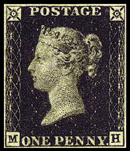|
The Penny Black, also known as the 1d black, was printed from eleven plates, each of which being individually identifiable. The stamps were printed using the line engraved (gravure, recess) printing method.
Penny Black stamps were printed by Perkins, Bacon and Petch. The actual presses used were very old dating from 1819 having been built by an American from Boston, called Joseph Perkins. However, they were efficient and continued producing British stamps until 1870. Stamps for the Cape of Good Hope, Mauritius, Trinidad and Western Australia were also printed on the press.

The printing press used to print Penny Black stamps
As mentioned before, 11 different printing plates were used. However, many of the 11 plates had more than one state due to various repairs and re-entries. Plate 1, the first plate to be use, deteriorated in quality very quickly and had to undergo serious repairs so that it is generally considered as two separate plates - 1a and 1b. Serious collectors of Penny Black stamps can usually work out what stamp a plate was printed from by identifying the small characteristics of each plate. Examples of these characteristics include the "O flaw", ray flaws, guide lines or double.
Some plates are rarer than other plates and plate 11 is the scarcest. Plate 11 is unusual in that the first printings were made in red ink at the end of January 1841. However, they were followed on the first and second of February by a short two-day run of 700 sheets. Despite this, plate 11 is still considered on of the ‘black’ plates. The British Library now displays the press.
The stamps were printed in sheets of 240 stamps. Each sheet consisted of 12 vertical columns and 20 horizontal rows.
Corner letters.
As a forgery precaution, "check" letters were placed in the corner squares of Penny Black stamps. The letters identified the position of each individual stamp on a sheet.
The right square letter indicates the vertical column. The letter A indicates the first column. The second column is B and so on across to L for the last (twelfth) column.
The left square letter indicates the horizontal row. So the first row is A, the second B, the third C and so on until row 20 which is indicated by the letter T.
For example, the stamp in the upper left hand corner was lettered AA and the stamp in the lower right hand corner of the sheet was labelled as TL.
Each letter combination is just as common or as rare as any other.

A block of Penny Black Stamps
When the printing plates were produced the lower squares were blank, and the letters were punched in by hand into the printing plate. As a consequence, the position of the letters in relation to the edges of the surrounding square varied. This attribute of the stamps allows expert collectors to be able to identify which plate an individual stamp comes from.
The corner letters of stamps were hand punched up until 1864. These stamps all have letters in the 2 bottom corner squares only. The upper corner squares contain stars. After 1864, line engraved issues had letters in all 4 corner squares and these letters were engraved rather than being hand punched. More significantly, they also had the plate numbers engraved onto the stamp, making the process of identifying a plate much simpler.
Penny Black stamps were imperforate . This meant that the postmaster or mistress had to cut out the stamps from the sheet by hand. As a result of careless cutting, many of the stamps have incomplete margins, the cuts often extending into the printed area of the stamp.
Each sheet of stamps contained 240 stamps. The stamps were printed on gummed paper with a single, simple watermark of a small crown on each stamp. All stamps printed before May 1855 had a small crown watermark in the centre of each stamp:
 
After May 1855, most stamps used the large crown watermark.
|





